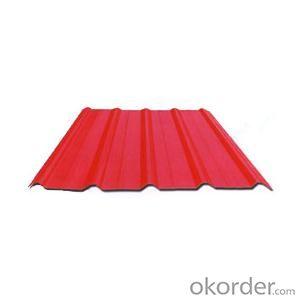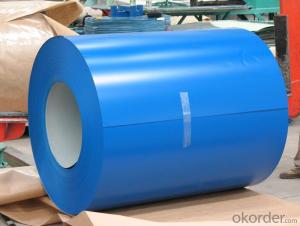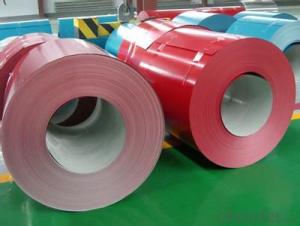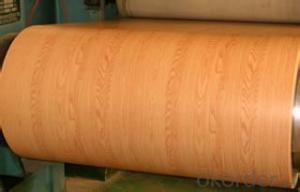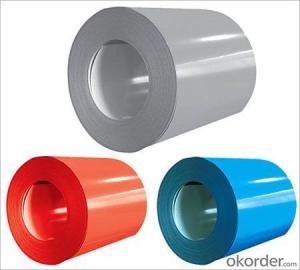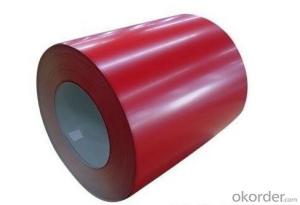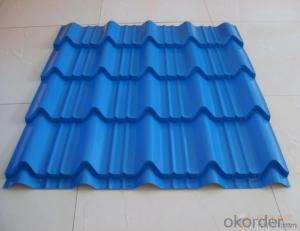Pre-Painted Galvanized/Aluzinc Steel Coil with Good Price Best Quality
- Loading Port:
- China main port
- Payment Terms:
- TT OR LC
- Min Order Qty:
- 50 m.t.
- Supply Capability:
- 10000 m.t./month
OKorder Service Pledge
OKorder Financial Service
You Might Also Like
1. Pre-Painted Galvanized/Aluzinc Steel Coil with Good Price Best Quality
With GI as base material, after pretreatment (degrease and chemical treatment ) and liquid dope with several layers of color, then after firing and cooling, finally the plate steel is called pre-painted galvanized (aluzinc) steel. Pre-painted galvanized steel is good capable of decoration, molding, corrosion resistance. It generally displays superior workability, durability and weather resistance.
2.Main Features of the Pre-Painted Galvanized/Aluzinc Steel Coil:
• Excellent process capability
• Smooth and flat surface
• Workability, durability
• Excellent heat resistance performance
• High strength
• Good formability
• Good visual effect
3.Pre-Painted Galvanized/Aluzinc Steel Coil Images
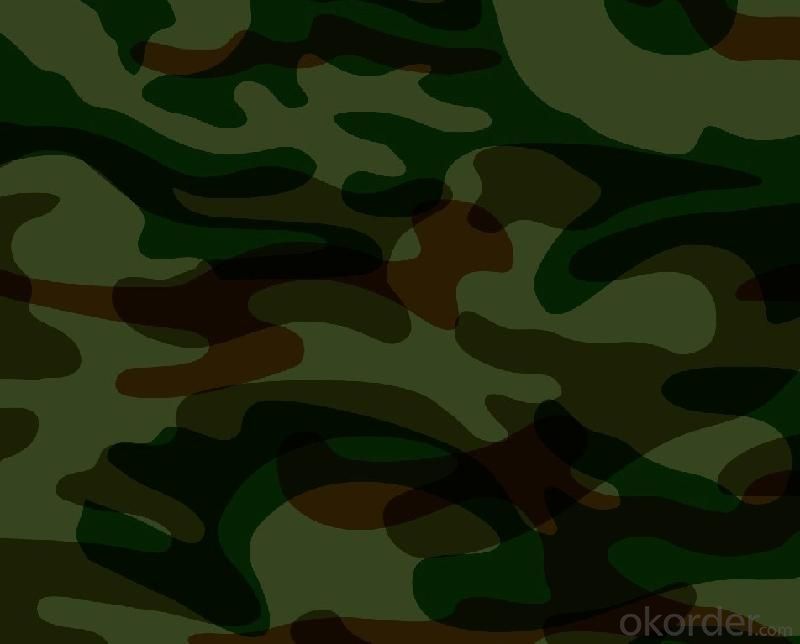
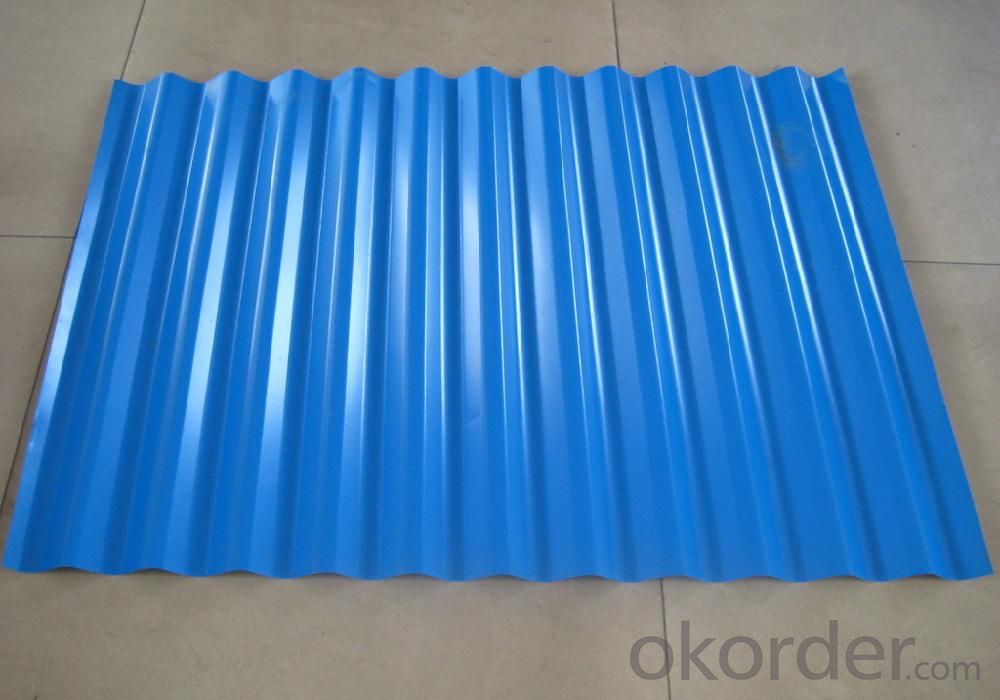
4.Pre-Painted Galvanized/Aluzinc Steel Coil Specification
Standard: AISI, ASTM, BS, DIN, GB, JIS
Grade: DX51D, DX52D
Thickness: 0.17-2.0mm
Brand Name: KMRLON
Model Number: coil
Type: Steel Coil
Technique: Cold Rolled
Surface Treatment: Coated
Application: Boiler Plate
Special Use: High-strength Steel Plate
Width: 20-1250mm
Length: customized
commoidty: pre-painted galvanized steel coil
Thickness: 0.13-4.0mm
width: 20-1250mm
zinc coating: 40-180g/m2
printing thickness: top side: 20+/-5 microns, back side: 5-7 microns
color: all RAL color
surface treatment: color coated
coil weight: 4-7 tons
coil ID: 508/610mm
packaging: standard seaworthy packing
5.FAQ of Pre-Painted Galvanized/Aluzinc Steel Coil
1. What’s the application of this product?
Roof, roof structure, surface sheet of balcony, frame of window, etc.
2. What’s the brand of the paint?
We use the best brand of all of the word—AKZO.
3. How to guarantee the quality of the products?
We have established the international advanced quality management system,every link from raw material to final product we have strict quality test;We resolutely put an end to unqualified products flowing into the market. At the same time, we will provide necessary follow-up service assurance.
4. How long can we receive the product after purchase?
Usually within thirty working days after receiving buyer’s advance payment or LC. We will arrange the factory manufacturing as soon as possible. The cargo readiness usually takes 15-25 days, but the shipment will depend on the vessel situation.
- Q: What are the different types of steel coil processing equipment?
- There are several different types of steel coil processing equipment used in the manufacturing industry. These equipment are designed to handle and process steel coils in various ways, allowing for efficient and accurate production. Some of the common types of steel coil processing equipment include: 1. Decoilers: Decoilers are used to unwind steel coils and feed them into the processing line. They are equipped with motorized systems that control the unwinding process, ensuring a steady supply of material. 2. Straighteners: Straighteners are used to flatten and straighten steel coils that may have become distorted during the coiling process. They use a series of rollers to remove any bends or waves in the material, ensuring a smooth and consistent feed into the next processing stage. 3. Slitters: Slitters are used to cut steel coils into narrower strips, allowing for the production of various widths of steel sheets or strips. They consist of multiple sets of circular blades that can be adjusted to cut the desired width. 4. Levelers: Levelers are used to correct any surface imperfections in steel coils, such as wavy or undulating surfaces. They use a series of rollers to apply pressure and reshape the material, resulting in a flat and even surface. 5. Shears: Shears are used to cut steel coils into specific lengths. They can be hydraulic or mechanical and are designed to provide clean and precise cuts, ensuring the desired dimensions are achieved. 6. Recoilers: Recoilers are used to rewind processed steel coils back into a tightly wound coil. They can be motorized or manual and are essential for storage and transportation purposes. 7. Edge trimmers: Edge trimmers are used to remove any excess material from the edges of steel coils. They ensure a clean and uniform edge, allowing for better handling and further processing. 8. Coil cars: Coil cars are used to transport steel coils within the processing facility. They are equipped with hydraulic or mechanical systems that allow for easy loading and unloading of coils onto other equipment. These are just some of the different types of steel coil processing equipment used in the industry. Each equipment plays a crucial role in the manufacturing process, ensuring the efficient production of high-quality steel products.
- Q: What's the best material for color coated steel coil?
- Color steel roll is a kind of composite material, also called color coating steel plate. It is produced by continuous coating on the production line by surface degreasing and phosphating etc. after being coated with organic coating, the product is made by baking. Color steel roll is a composite material, both steel and organic materials, both of them a little. Both the mechanical strength of steel plate and easy molding performance, but also organic materials, good decoration, corrosion resistance.
- Q: What are the environmental considerations of using steel coils?
- There are several environmental considerations associated with using steel coils. Firstly, the production of steel coils requires a significant amount of energy and raw materials, which can contribute to greenhouse gas emissions and environmental degradation. Additionally, the extraction and processing of iron ore for steel production can have negative impacts on land, water, and air quality. Moreover, the transportation of steel coils, especially over long distances, can result in emissions from vehicles and contribute to pollution. Lastly, the disposal of steel coils at the end of their lifecycle poses challenges as they can be difficult to recycle and may end up in landfills, further contributing to waste accumulation. Overall, the environmental implications of using steel coils highlight the need for sustainable practices in their production, transportation, and disposal.
- Q: What is the role of steel coils in the supply chain?
- The supply chain heavily relies on steel coils, especially in the manufacturing and construction sectors. These coils, typically made from hot-rolled steel, are essential raw materials for a wide range of products like automobiles, appliances, construction materials, and industrial goods. The journey of steel coils in the supply chain begins with the production of raw steel, which is then processed and shaped into coils at steel mills. These coils are then transported to different manufacturing facilities where they are transformed into finished products. Throughout this process, steel coils act as an intermediary product that is easy to transport, stack, and manipulate according to various manufacturing requirements. One major advantage of using steel coils in the supply chain is their strength and durability. Steel possesses high tensile strength, enabling it to withstand substantial loads and pressures. This makes steel coils perfect for applications that require sturdy materials like structural components in buildings, heavy machinery, and vehicles. Furthermore, steel coils offer high customization, allowing manufacturers to tailor their dimensions and specifications to meet specific needs. This flexibility ensures the efficient delivery of steel coils that align with the requirements of diverse industries and projects. In terms of logistics, steel coils are typically transported in large quantities using specialized equipment such as flatbed trucks, railcars, or even ships. Effective logistics planning is crucial to ensure timely delivery and minimize transportation costs. Additionally, proper storage and handling are vital to prevent damage to the coils during transit and storage. Overall, steel coils play a vital role in the supply chain as versatile raw materials that can be shaped and transformed into various end products. Their strength, durability, and flexibility make them an essential component in industries that rely on high-quality steel, ultimately contributing to the overall economic growth and development of numerous sectors.
- Q: I know that mild steel is more brittle than cast iron....but that is all.......please help??Thank you in advance......Ruby:D
- I know that mild steel is more brittle than cast iron You know wrong - cast iron is very brittle and mild steel is easy to bend and work. Cast iron is a high carbon product while mild steel is much lower carbon
- Q: How are defects in steel coils detected and resolved?
- Defects in steel coils are typically detected through various non-destructive testing methods such as visual inspection, ultrasonic testing, magnetic particle testing, and eddy current testing. Once a defect is identified, it is resolved through processes like grinding, polishing, welding, or cutting out and replacing the affected area. The specific resolution method depends on the type and severity of the defect, ensuring that the steel coils meet the required quality standards before further processing or usage.
- Q: Why are steel saucepans and tea kettles covered with copper on the outside and the bottom? what r the goals of having high-quality pans that are thick and tea kettles that are thin walled?
- Stainless steel is less conductive than copper. However, steel will retain heat longer and thus be distributed more evenly. (hence the thick bottoms, but also for balance). Copper on tea kettles is ideal to bring water up to a boil rapidly but since your not really cooking food, temperature distribution or control doesn't really matter. Now if your cooking sensitive food, then it does matter. For example, the use of a double boiler is preferred for chocolates. Temperature and distribution is critical. As far as relatively inexpensive copper clad pots and pans such as Revereware? Well, I don't see a difference but perhaps they did some testing.
- Q: I was wondering whether anyone knew if painted steels rusts at the same speed as steel that isn't painted. Also, does steel rust quicker than aluminium?Thank you
- If the steel is properly prepped when painted, then it would last a long time before any rust or corrosion sets in. This still all depends if the item is subjected to water or salt and if the item you painted is not scratched in any way, once exposed from the paint, the rust will begin rapidly. As far as aluminum, no it will not rust, but you do get aluminum oxidation. It gets a white flakey appearance when it begins to oxidize. Now if you are thinking of painting the rims on a car, i recommend scuffing the rim, priming it, lightly sanding and then paint to the color of choice and for the final touch apply a clear coat on the rims to help avoid the rusting. Use a paint such as rustoleum to prolong the effects of rust settling in. good luck..... good luck.....
- Q: What are the disadvantages of using steel coils?
- One disadvantage of using steel coils is their weight and size, which can make transportation and handling challenging. Additionally, steel coils are susceptible to corrosion, requiring regular maintenance and protective measures to prevent rusting. The production of steel coils also contributes to environmental pollution due to the energy-intensive manufacturing process. Lastly, the upfront cost of steel coils can be relatively high compared to other materials, which may not be suitable for budget-constrained projects.
- Q: How are steel coils used in the agricultural sector?
- Various purposes in the agricultural sector call for the widespread use of steel coils. One primary utilization is seen in the construction of farm machinery and equipment. Tractors, plows, harvesters, and other heavy-duty machinery are frequently manufactured using steel coils. The exceptional strength and durability of steel make it an ideal material for such applications, as it can endure the challenging conditions of agricultural work. Furthermore, agricultural buildings and structures heavily rely on steel coils in their construction. Steel is renowned for its superior structural integrity, making it a popular choice for barns, storage units, and other agricultural facilities. Steel coils are frequently employed to establish the framework and support systems of these structures, providing stability and long-lasting durability. Moreover, irrigation systems also rely on steel coils in their production. Steel coils are often used to create the pipes and tubes used for water transportation in agricultural irrigation systems. Steel's resistance to corrosion and its ability to handle high-pressure flows make it an excellent choice for this particular application. To summarize, steel coils hold a critical role in the agricultural sector. Whether it be the construction of farm machinery and buildings or the development of irrigation systems, steel's strength and durability make it the preferred material in this industry.
Send your message to us
Pre-Painted Galvanized/Aluzinc Steel Coil with Good Price Best Quality
- Loading Port:
- China main port
- Payment Terms:
- TT OR LC
- Min Order Qty:
- 50 m.t.
- Supply Capability:
- 10000 m.t./month
OKorder Service Pledge
OKorder Financial Service
Similar products
Hot products
Hot Searches
Related keywords
